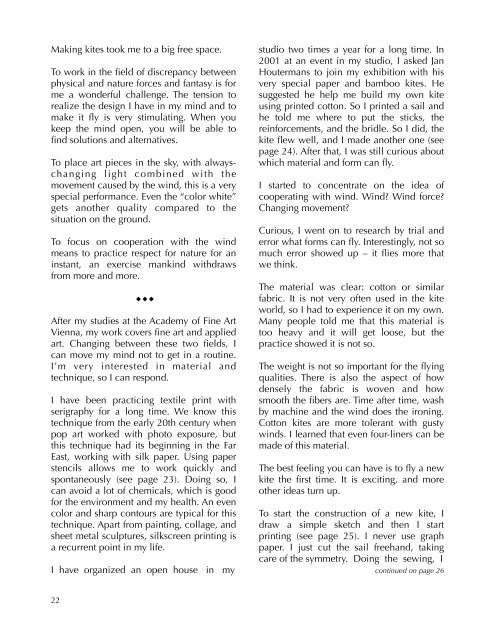Create successful ePaper yourself
Turn your PDF publications into a flip-book with our unique Google optimized e-Paper software.
Making kites took me to a big free space.<br />
To work in the field of discrepancy between<br />
physical and nature forces and fantasy is for<br />
me a wonderful challenge. The tension to<br />
realize the design I have in my mind and to<br />
make it fly is very stimulating. When you<br />
keep the mind open, you will be able to<br />
find solutions and alternatives.<br />
To place art pieces in the sky, with alwayschanging<br />
light combined with the<br />
movement caused by the wind, this is a very<br />
special performance. Even the “color white”<br />
gets another quality compared to the<br />
situation on the ground.<br />
To focus on cooperation with the wind<br />
means to practice respect for nature for an<br />
instant, an exercise mankind withdraws<br />
from more and more.<br />
◆◆◆<br />
After my studies at the Academy of Fine Art<br />
Vienna, my work covers fine art and applied<br />
art. Changing between these two fields, I<br />
can move my mind not to get in a routine.<br />
I’m very interested in material and<br />
technique, so I can respond.<br />
I have been practicing textile print with<br />
serigraphy for a long time. We know this<br />
technique from the early 20th century when<br />
pop art worked with photo exposure, but<br />
this technique had its beginning in the Far<br />
East, working with silk paper. Using paper<br />
stencils allows me to work quickly and<br />
spontaneously (see page 23). Doing so, I<br />
can avoid a lot of chemicals, which is good<br />
for the environment and my health. An even<br />
color and sharp contours are typical for this<br />
technique. Apart from painting, collage, and<br />
sheet metal sculptures, silkscreen printing is<br />
a recurrent point in my life.<br />
I have organized an open house in my<br />
studio two times a year for a long time. In<br />
2001 at an event in my studio, I asked Jan<br />
Houtermans to join my exhibition with his<br />
very special paper and bamboo kites. He<br />
suggested he help me build my own kite<br />
using printed cotton. So I printed a sail and<br />
he told me where to put the sticks, the<br />
reinforcements, and the bridle. So I did, the<br />
kite flew well, and I made another one (see<br />
page 24). After that, I was still curious about<br />
which material and form can fly.<br />
I started to concentrate on the idea of<br />
cooperating with wind. Wind? Wind force?<br />
Changing movement?<br />
Curious, I went on to research by trial and<br />
error what forms can fly. Interestingly, not so<br />
much error showed up – it flies more that<br />
we think.<br />
The material was clear: cotton or similar<br />
fabric. It is not very often used in the kite<br />
world, so I had to experience it on my own.<br />
Many people told me that this material is<br />
too heavy and it will get loose, but the<br />
practice showed it is not so.<br />
The weight is not so important for the flying<br />
qualities. There is also the aspect of how<br />
densely the fabric is woven and how<br />
smooth the fibers are. Time after time, wash<br />
by machine and the wind does the ironing.<br />
Cotton kites are more tolerant with gusty<br />
winds. I learned that even four-liners can be<br />
made of this material.<br />
The best feeling you can have is to fly a new<br />
kite the first time. It is exciting, and more<br />
other ideas turn up.<br />
To start the construction of a new kite, I<br />
draw a simple sketch and then I start<br />
printing (see page 25). I never use graph<br />
paper. I just cut the sail freehand, taking<br />
care of the symmetry. Doing the sewing, I<br />
continued on page 26<br />
22


